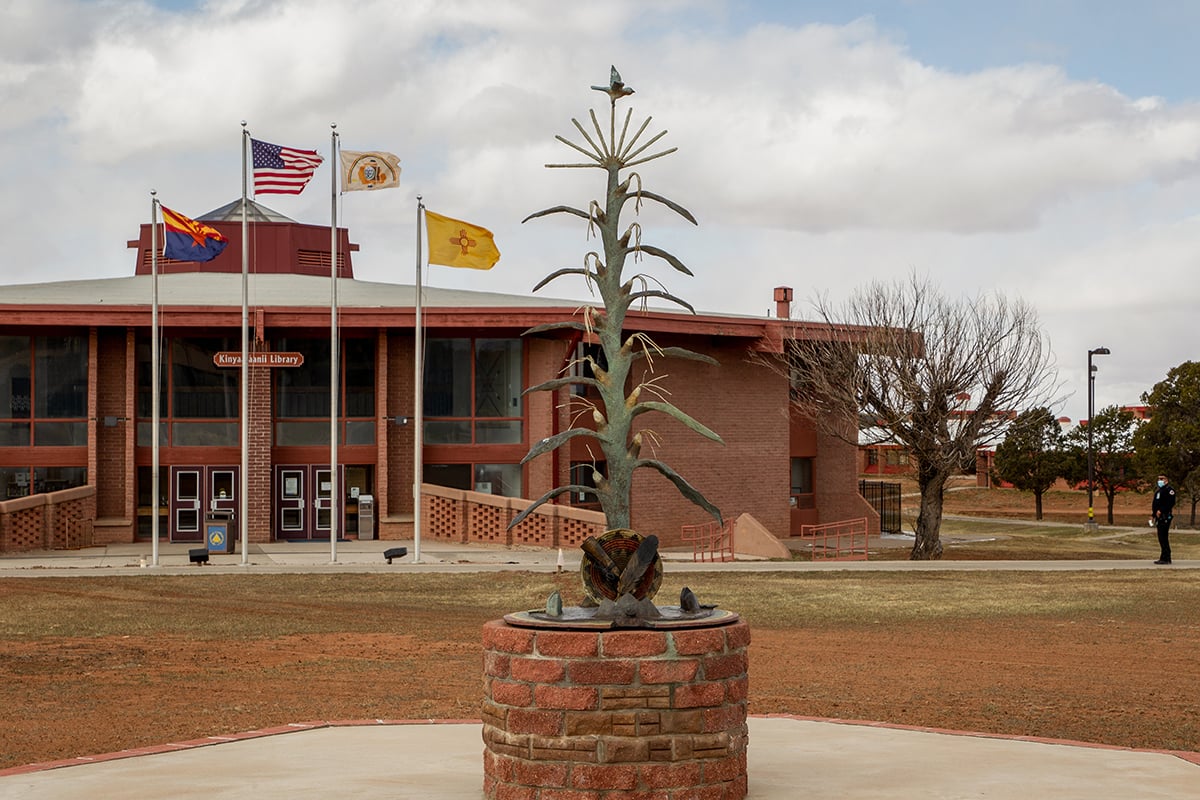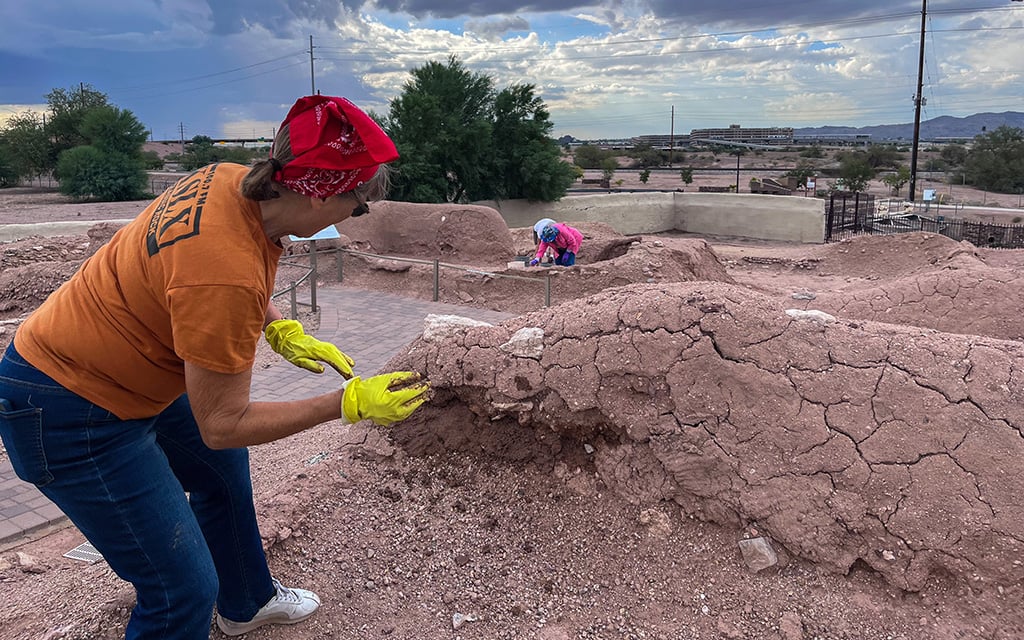
Throwing the mud is the only way to get it to stick. (Photo by Amber Victoria Singer/Cronkite News)

Volunteers stabilize the va’aki about once a month by throwing mud at it. (Photo by Amber Victoria Singer/Cronkite News)
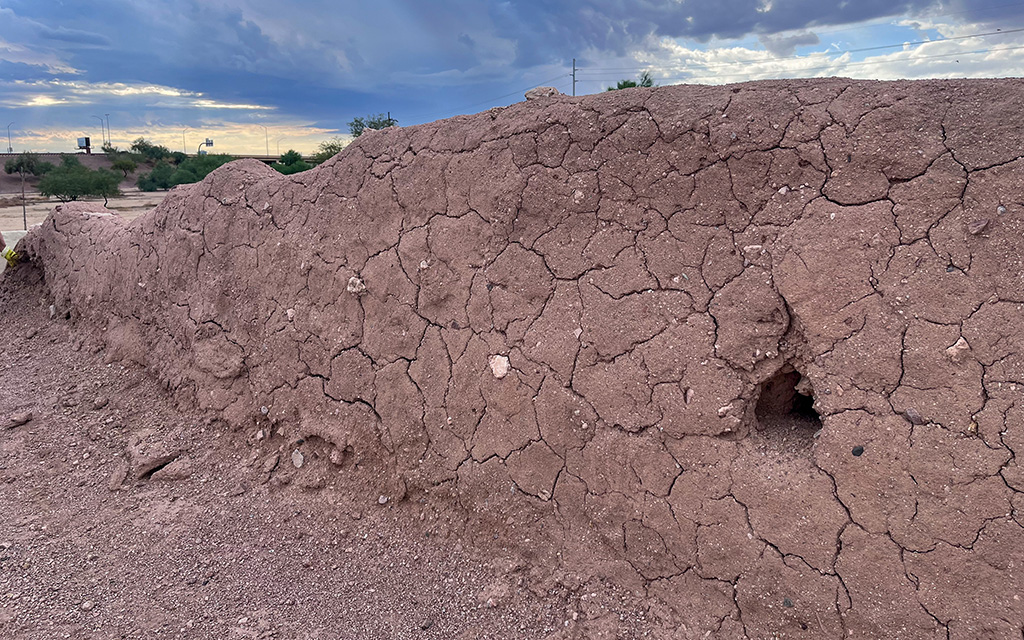
Over the centuries, the va’aki’s dirt walls have eroded. (Photo by Amber Victoria Singer/Cronkite News)
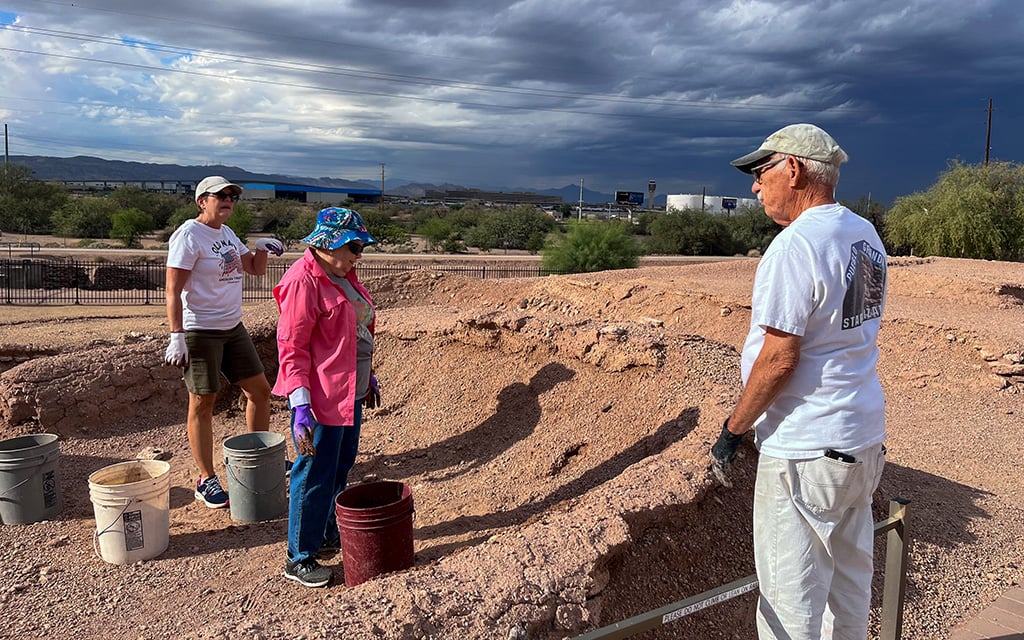
Jim Britton, right, has been a mudslinger at the Pueblo Grande va’aki for 28 years. He teaches the process to new volunteers. (Photo by Amber Victoria Singer/Cronkite News)
PHOENIX – Most museums ask guests not to touch the artifacts, but once a month, Pueblo Grande Museum and Archaeological Park encourages visitors to throw mud at a more than 800-year-old structure.
The va’aki, popularly called a platform mound, was built sometime in the Classic Period (1150-1450 C.E.) by the Hohokam, according to city of Phoenix archaeologists.
The mound “is the last visible part of the village of Pueblo Grande that you can still see,” said Laurene Montero, Phoenix’s city archaeologist. “It was a kind of spiritual place. I guess you could call it public architecture.”
When it isn’t too hot or too wet, volunteers gather at the museum once a month – usually September through June – to get their hands dirty.
Montero said the purpose of the mudslinging is to stabilize the structure, and throwing the mud is the only way to get it to stick.
“You don’t want to change the structure of the va’aki at all,” Montero said. “But you want to patch up any holes, sometimes rodent holes, fill them with dirt, and places where the walls are starting to crumble.”
Volunteers do not use your everyday, run-of-the-mill mud to throw, according to Jim Britton, who has been slinging mud at the museum for 28 years.
“The mud that we’re making here to be applied to the eroded areas of the walls is made of two parts dirt and one part sand,” he said. “And then to that we’re adding … a polyvinyl polymer that is used to increase the ability of the dirt to stay in place during rain.”
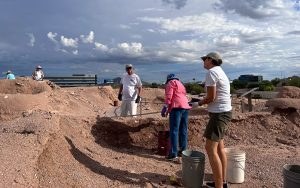
The va’aki, popularly known as the platform mound, was built by the Hohokam during the Classic Period (1150-1450 C.E.). (Photo by Amber Victoria Singer/Cronkite News)
Britton came up with the idea to add the polymer about 23 years ago. Now it’s used at a few other sites as well, he said.
The mud is mixed in a large rectangular bin on the ground. It takes two people with hoes – one pulls it one way, then the other pulls it the other way.
Once the mud is mixed up, it’s driven up the hill to the va’aki in buckets on a utility vehicle that looks like a cross between a golf cart and a small monster truck.
“Before the mud is applied, you have to brush off any loose material that has been eroded,” Britton said, “then wet down the surface.”
Some people scoop and squirt water with empty plastic bottles, but Britton prefers a different method.
“The way I like to do it is to take a big water brush and swing it on,” he said.
The water brush is the same as the brushes that are used to remove loose dirt, just wet. Over the course of the morning, quite a few dirt brushes became water brushes.
Once the loose dirt is removed and the va’aki wall is wet, the fun begins.
At a recent mudslinging event, volunteers laughed and joked with each other as they scooped mud out of the bucket and flung it at the ancient structure. Britton’s white hat, white shirt, white pants and white shoes soon sported flecks of mud.
He said it’s important to preserve the va’aki for the next generation.
“We’re saving the past for the future,” he said. “So when your grandkids want to see how the people lived 800 years ago, they have something to look at.”

Jim Britton shows a volunteer how to fill a hole in the wall. (Photo by Amber Victoria Singer/Cronkite News)
The va’aki is one of only two remaining in the Valley; the other is in Mesa. The one at Pueblo Grande was donated to the city by Thomas Armstrong in 1924, according to the city of Phoenix. The museum opened next to it five years later.
Sitting atop a human-made hill, the va’aki consists of a group of rooms made of cracking dirt walls. There is no longer a roof, but there are spaces for doorways.
The highest room in the va’aki is the solstice room. During the summer solstice sunrise and winter solstice sunset, the sun lines up perfectly with the room’s two doors. Community leaders used this room to track solstices in order to plan harvests and important religious ceremonies, according to a plaque at the site.
“The platform mound itself was likely a place where villagers with key roles lived, at least part time,” said Pueblo Grande Museum research associate Doug Mitchell in a lecture on the museum’s website.
Mitchell is part of a group of archaeologists and researchers who did work to find out more about the va’aki and the village surrounding it. Since the Pueblo Grande archival project began in 1989, people have been publishing results of archaeological investigations that took place from 1929 through the 1980s.
“Decades of site erosion and early excavations by professionals, educators and students had left the site damaged and exposed,” he said. “And none of this work had ever been reported.”
During archaeological excavations that started as early as 1901, research methods were different than they are now. There was less log-keeping, so today’s archaeologists don’t know exactly where certain artifacts were found and when.
“The nature of the early collections from Pueblo Grande limited research questions that could be addressed,” Mitchell said.
Work to stabilize the va’aki began in the late 1980s, when the museum was given money for a stabilization and archival project.
Now, over 30 years later, volunteers are still working to preserve what’s left of the prehistoric Pueblo Grande village.
To volunteer to stabilize the va’aki, email [email protected].

